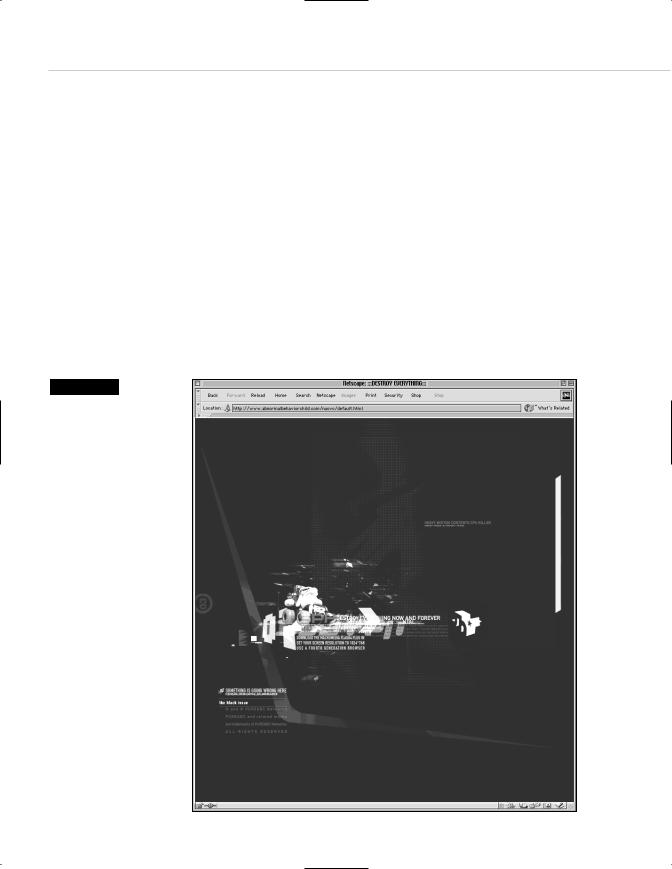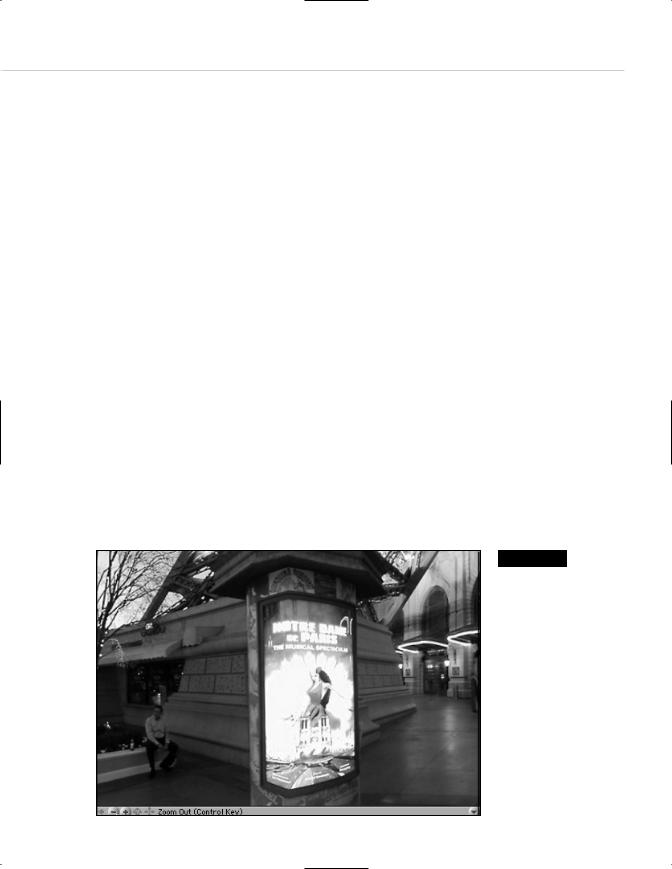
- •Taking Your Talent to the Web
- •Introduction
- •1 Splash Screen
- •Meet the Medium
- •Expanding Horizons
- •Working the Net…Without a Net
- •Smash Your Altars
- •Breath Mint? Or Candy Mint?
- •Where’s the Map?
- •Mars and Venus
- •Web Physics: Action and Interaction
- •Different Purposes, Different Methodologies
- •Web Agnosticism
- •Point #1: The Web Is Platform-Agnostic
- •Point #2: The Web Is Device-Independent
- •The 18-Month Pregnancy
- •Chocolatey Web Goodness
- •’Tis a Gift to Be Simple
- •Democracy, What a Concept
- •Instant Karma
- •The Whole World in Your Hands
- •Just Do It: The Web as Human Activity
- •The Viewer Rules
- •Multimedia: All Talking! All Dancing!
- •The Server Knows
- •It’s the Bandwidth, Stupid
- •Web Pages Have No Secrets
- •The Web Is for Everyone!
- •Swap text and code for images
- •Prune redundancy
- •Cache as Cache Can
- •Much Ado About 5K
- •Screening Room
- •Liquid Design
- •Color My Web
- •Thousands Weep
- •Gamma Gamma Hey!
- •Typography
- •The 97% Solution
- •Points of Distinction
- •Year 2000—Browsers to the Rescue
- •Touch Factor
- •Appropriate Graphic Design
- •User Knowledge
- •What Color Is Your Concept?
- •Business as (Cruel and) Usual
- •The Rise of the Interface Department
- •Form and Function
- •Copycats and Pseudo-Scientists
- •Chaos and Clarity
- •A Design Koan: Interfaces Are a Means too Often Mistaken for an End
- •Universal Body Copy and Other Fictions
- •Interface as Architecture
- •Ten (Okay, Three) Points of Light
- •Be Easily Learned
- •Remain Consistent
- •Continually Provide Feedback
- •GUI, GUI, Chewy, Chewy
- •It’s the Browser, Stupid
- •Clarity Begins at Home (Page)
- •I Think Icon, I Think Icon
- •Structural Labels: Folding the Director’s Chair
- •The Soul of Brevity
- •Hypertext or Hapless Text
- •Scrolling and Clicking Along
- •Stock Options (Providing Alternatives)
- •The So-Called Rule of Five
- •Highlights and Breadcrumbs
- •Consistent Placement
- •Brand That Sucker!
- •Why We Mentioned These Things
- •The year web standards broke, 1
- •The year web standards broke, 2
- •The year web standards broke, 3
- •The year the bubble burst
- •5 The Obligatory Glossary
- •Web Lingo
- •Extranet
- •HTML
- •Hypertext, hyperlinks, and links
- •Internet
- •Intranet
- •JavaScript, ECMAScript, CSS, XML, XHTML, DOM
- •Web page
- •Website
- •Additional terminology
- •Web developer/programmer
- •Project manager
- •Systems administrator (sysadmin) and network administrator (netadmin)
- •Web technician
- •Your Role in the Web
- •Look and feel
- •Business-to-business
- •Business-to-consumer
- •Solve Communication Problems
- •Brand identity
- •Restrictions of the Medium
- •Technology
- •Works with team members
- •Visually and emotionally engaging
- •Easy to navigate
- •Compatible with visitors’ needs
- •Accessible to a wide variety of web browsers and other devices
- •Can You Handle It?
- •What Is the Life Cycle?
- •Why Have a Method?
- •We Never Forget a Phase
- •Analysis (or “Talking to the Client”)
- •The early phase
- •Design
- •Brainstorm and problem solve
- •Translate needs into solutions
- •Sell ideas to the client
- •Identify color comps
- •Create color comps/proof of concept
- •Present color comps and proof of concept
- •Receive design approval
- •Development
- •Create all color comps
- •Communicate functionality
- •Work with templates
- •Design for easy maintenance
- •Testing
- •Deployment
- •The updating game
- •Create and provide documentation and style guides
- •Provide client training
- •Learn about your client’s methods
- •Work the Process
- •Code Wars
- •Table Talk
- •XHTML Marks the Spot
- •Minding Your <p>’s and q’s
- •Looking Ahead
- •Getting Started
- •View Source
- •A Netscape Bonus
- •The Mother of All View Source Tricks
- •Doin’ it in Netscape
- •Doin’ it in Internet Explorer
- •Absolutely Speaking, It’s All Relative
- •What Is Good Markup?
- •What Is Sensible Markup?
- •HTML as a Design Tool
- •The Frames of Hazard
- •Please Frame Safely
- •Framing Your Art
- •<META> <META> Hiney Ho!
- •Search Me
- •Take a (Re)Load Off
- •WYSIWYG, My Aunt Moira’s Left Foot
- •Code of Dishonor
- •WYS Is Not Necessarily WYG
- •Publish That Sucker!
- •HTMHell
- •9 Visual Tools
- •Photoshop Basics: An Overview
- •Comp Preparation
- •Dealing with Color Palettes
- •Exporting to Web-Friendly Formats
- •Gamma Compensation
- •Preparing Typography
- •Slicing and Dicing
- •Rollovers (Image Swapping)
- •GIF Animation
- •Create Seamless Background Patterns (Tiles)
- •Color My Web: Romancing the Cube
- •Dither Me This
- •Death of the Web-Safe Color Palette?
- •A Hex on Both Your Houses
- •Was Blind, but Now I See
- •From Theory to Practice
- •Format This: GIFs, JPEGs, and Such
- •Loves logos, typography, and long walks in the woods
- •GIFs in Photoshop
- •JPEG, the Other White Meat
- •Optimizing GIFs and JPEGs
- •Expanding on Compression
- •Make your JPEGS smaller
- •Combining sharp and blurry
- •Animated GIFs
- •Creating Animations in ImageReady
- •Typography
- •The ABCs of Web Type
- •Anti-Aliasing
- •Specifying Anti-Aliasing for Type
- •General tips
- •General Hints on Type
- •The Sans of Time
- •Space Patrol
- •Lest We Fail to Repeat Ourselves
- •Accessibility, Thy Name Is Text
- •Slicing and Dicing
- •Thinking Semantically
- •Tag Soup and Crackers
- •CSS to the Rescue…Sort of
- •Separation of Style from Content
- •CSS Advantages: Short Term
- •CSS Advantages: Long Term
- •Compatibility Problems: An Overview
- •Working with Style Sheets
- •Types of Style Sheets
- •External style sheets
- •Embedding a style sheet
- •Adding styles inline
- •Fear of Style Sheets: CSS and Layout
- •Fear of Style Sheets: CSS and Typography
- •Promise and performance
- •Font Size Challenges
- •Points of contention
- •Point of no return: browsers of the year 2000
- •Absolute size keywords
- •Relative keywords
- •Length units
- •Percentage units
- •Looking Forward
- •11 The Joy of JavaScript
- •What Is This Thing Called JavaScript?
- •The Web Before JavaScript
- •JavaScript, Yesterday and Today
- •Sounds Great, but I’m an Artist. Do I Really Have to Learn This Stuff?
- •Educating Rita About JavaScript
- •Don’t Panic!
- •JavaScript Basics for Web Designers
- •The Dreaded Text Rollover
- •The Event Handler Horizon
- •Status Quo
- •A Cautionary Note
- •Kids, Try This at Home
- •The Not-So-Fine Print
- •The Ever-Popular Image Rollover
- •A Rollover Script from Project Cool
- •Windows on the World
- •Get Your <HEAD> Together
- •Avoiding the Heartbreak of Linkitis
- •Browser Compensation
- •JavaScript to the Rescue!
- •Location, location, location
- •Watching the Detection
- •Going Global with JavaScript
- •Learning More
- •12 Beyond Text/Pictures
- •You Can Never Be Too Rich Media
- •Server-Side Stuff
- •Where were you in ‘82?
- •Indiana Jones and the template of doom
- •Serving the project
- •Doing More
- •Mini-Case Study: Waferbaby.com
- •Any Size Kid Can Play
- •Take a Walk on the Server Side
- •Are You Being Served?
- •Advantages of SSI
- •Disadvantages of SSI
- •Cookin’ with Java
- •Ghost in the Virtual Machine
- •Java Woes
- •Java Woes: The Politically Correct Version
- •Java Joys
- •Rich Media: Exploding the “Page”
- •Virtual Reality Modeling Language (VRML)
- •SVG and SMIL
- •SMIL (through your fear and sorrow)
- •Romancing the logo
- •Sounds dandy, but will it work?
- •Promises, Promises
- •Turn on, Tune in, Plug-in
- •A Hideous Breach of Reality
- •The ubiquity of plug-ins
- •The Impossible Lightness of Plug-ins
- •Plug-ins Most Likely to Succeed
- •Making It Work: Providing Options
- •The “Automagic Redirect”
- •The iron-plated sound console from Hell
- •The Trouble with Plug-ins
- •If Plug-ins Run Free
- •Parting Sermon
- •13 Never Can Say Goodbye
- •Separation Anxiety
- •A List Apart
- •Astounding Websites
- •The Babble List
- •Dreamless
- •Evolt
- •Redcricket
- •Webdesign-l
- •When All Else Fails
- •Design, Programming, Content
- •The Big Kahunas
- •Beauty and Inspiration
- •Index

chapter 12
Beyond Text/Pictures
ON FIRST DISCOVERING THAT THE WEB IS NOT PRINT, many designers see only the
drawbacks: poor typographic resolution; a limited pool of installed user fonts; bandwidth bugaboos; the need to compensate for browser, platform, and hardware differences; and the awkwardness of trying to read a computer screen in the bathroom.
As we start to become genuine web designers, though, most of us see more advantages than disadvantages in the Web’s distinctive differences from print. For example, instant worldwide distribution looks pretty darned good after wrestling with print shops and mail houses.
The longer we work at it, the more we marvel at the Web’s ability to provide universal access across seemingly unbridgeable gaps of technology, nationality, economic and political systems, and physical ability or disability.
As these barriers are crossed, the human spirit becomes less isolated, suspicion and intolerance begin to fade, and we learn to appreciate each other’s differences instead of fearing them. These benefits will greatly increase if the whole world gets to come along for the ride. They will greatly diminish if too many humans get left behind.

328 HOW: Beyond Text/Pictures
This, the substance of the vision of the founders of the Web, should be enough. But there is more. In particular, there are the two profound differences between the Web and print that we’ll discuss in this chapter:
1.The ability to develop not simply static pages, but full-fledged, dynamic experiences
2.The visual, sonic, and interactive possibilities inherent in rich media, whether it is delivered through emerging web standards or popular plug-in technologies
These two unique strengths of the Web have tremendous implications for business and for art. Each has played a huge part in popularizing the medium. Each brims with powerful potential that designers and developers have barely begun to tap. Each also has the potential to be abused.
Figure 12.1
Nicola Stumpo’s “Destroy Everything” is a noncommercial, nonnarrative Flash site that eats
your screen alive. Stumpo’s emotions are probably inexpressible in any medium outside Macromedia Flash (http://www. abnormalbehaviorchild. com/).

Taking Your Talent to the Web |
329 |
PRELUDE TO THE AFTERNOON OF DYNAMIC
WEBSITES
In Chapter 11, “The Joy of JavaScript,” we saw how JavaScript and its big brother, the Document Object Model (DOM), facilitate interactivity that printed media can only dream about. In the pages that follow, we’ll look at additional and powerful ways of making the Web more interactive.
Dynamic sites enable web users to locate information, store phone numbers in a shared contact database, buy holiday gifts without braving crowded shopping centers, or view “adult” material without shame until the baby-sitter barges in.
In this chapter, we will see how web agencies use server-side applications to build sites that let users do things. We’ll look at where the web designer
fits in and how server-side applications help us manage immense content sites or change text and appearance in response to user actions. We’ll also discuss how small shops and freelancers can get in on the action even if they don’t have casts of thousands and budgets of millions at their disposal.
We’ll also see how technologies like Java can compensate for “missing pieces” in our visitors’ browser setups or unleash full-fledged software programs that run right in the browser. And we’ll explore Java’s potential beyond the desktop.
Figure 12.2
Here is a tranquil moment outside the Eiffel Tower, captured in all its panoramic, Sensurround glory courtesy of Apple’s QuickTime VR—part of the QuickTime plug-in. Print cannot do this (http:// www.apple.com/).

330 HOW: Beyond Text/Pictures: The Form of Function
You Can Never Be Too Rich Media
After all that, we’ll examine emerging “multimedia” web standards that are almost ready for prime time and take a peek and a poke at plug-in technologies that can radically enhance your sites—if used with respect for the realities of average web users.
These technologies are not for every site, but, when appropriate, they can enhance the web user’s experience tremendously. Used poorly, of course, they lead to less satisfying experiences. We will explore all these technologies and consider what causes both kinds of experiences.
Knowing you as we do, we’ll start with the drier, more technical stuff because if we saved it for later, you’d never read it.
THE FORM OF FUNCTION: DYNAMIC
TECHNOLOGIES
Think back to our earlier discussion of Perl versus JavaScript in Chapter 2,
“Designing for the Medium.” As far as the Web is concerned, Perl is most often used in server-side transactions, such as the processing of a visitorsubmitted mail form. You might remember that a server-side technology is one in which the computing process takes place on the web server (hence the name) rather than the end-user’s PC. With Perl, number-crunching tasks fall to the web server, while the visitor’s computer sits idly, waiting.
We contrasted Perl with JavaScript, whose actions take place in the browser. With JavaScript, the end-user’s computer (the “client,” in geek parlance) does the heavy lifting. JavaScript is a client-side technology. Naturally, the dynamic technologies we’re about to consider do some work on the client side and some on the server side. After all, the two sides are continually interacting. If the two sides, client and server, were not continually interacting, you would not have web transactions; you would just have machines sitting around doing nothing, like Teamsters.
But though they necessarily move from one realm to the other, most of the dynamic technologies we’re about to discuss do the bulk of their work either on the server or on the user’s desktop. Sometimes where they work
